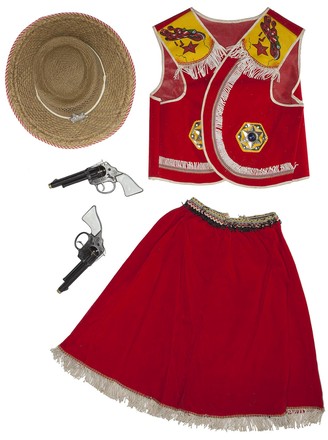License Pioneers
During the 1940s
Lindsay & Co began using Buffalo Bill as their registered trademark, tapping
into the boom in television westerns such as Annie Oakley, Rawhide and Bonanza.
Many of the western costumes were manufactured under licence from the
large motion picture companies including Walt Disney and Warner Brothers in the
United States. The
Lindsays pioneered these
licensing agreements in Australia
and the introduction of television in Australia in 1956 opened the way for
Lindsay’s to make the most of the influx of American television
programmes. Lindsay costumes enabled
children to become their favourite superhero or character from ‘Spiderman’ to
‘Mickey Mouse’, and ‘Zorro’ to ‘The Flying Nun’. Children could be Roy Rogers,
Smokey Dawson or Elly May from The Beverley Hillbillies.
Annie get your guns
During the mid-twentieth century the
Annie Oakley television show popularised the quintessential cowgirl’s costume.
So many little girls wanted to dress up as Annie, being smart, independent,
competitive and stylish and symbolising law and order she was the perfect role
model for Australian girls. Beginning with the Annie Oakley costume range,
Lindsay & Co continued to develop costumes with special appeal to girls including
Batgirl, Wonder Woman and nurses outfits.
An iconic Australian company
AL Lindsay & Co are an
iconic Australian company that produced a wide range of children’s toys and
costumes from the 1930’s through to the present. Initially, they produced ‘Cowboy and Indian’ costumes and a range of
calico tents. Lindsay & Co extended the reach of the company into a greatly
expanded post-war market developing costumes with a special appeal to girls.
Outfits were routinely devised for both boys and girls: cowboys and cowgirls;
Indian braves and squaws; Batman and Batgirl; Tarzan and Jane; doctors and
nurses; Robin Hood and Maid Marion; and Superman and Wonder Woman.
War effort
During the
Second World War all non-essential industries were put on hold, Lindsay & Co were
closed for five months but were successful in their appeal for a special
dispensation to continue business. Albert Lindsay was given a permit to reopen
provided he only employed people not covered by manpower regulations (ie. widows,
people over the age of 65 or disabled workers). Albert’s philosophy was that he
was doing war service by providing toys for the children of men and women who
were fighting.
Costume inspiration from family in the know
All members of the Lindsay family
have been instrumental in delivering a diverse range of childrens' costumes. In
the beginning, Albert Lindsay made feather dusters from turkey feathers, he was
then inspired to make Indian head dresses with the left over feathers.In the 1950s, with the popularisation of
Davey Crocket, Albert’s son Philip sourced hundreds of fox tails to make the
famous ‘racoon skin’ hats. And the
inspiration for the Nurses costume came to Hilarie and Philip Lindsay one day whilst
watching their young daughters playing in the garden with handkerchiefs on
their heads, pretending to be nurses.



 Back to list
Back to list